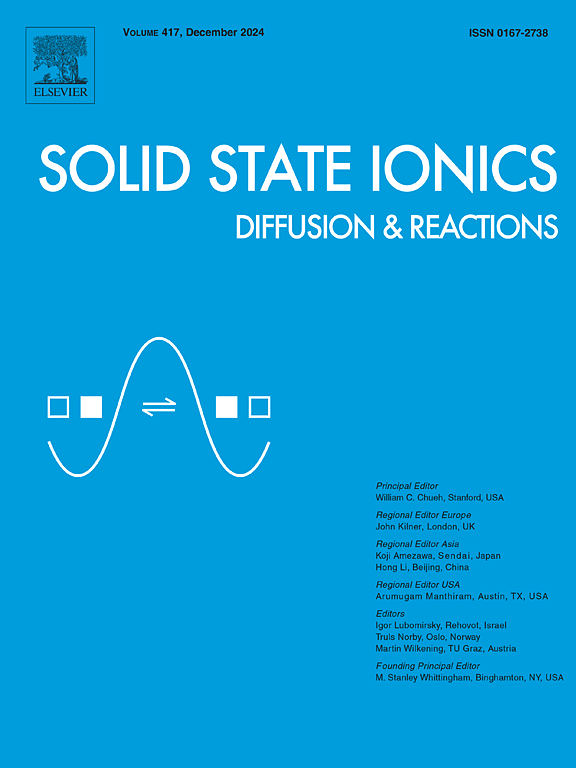Synergistic effects of halloysite nanotubes in electrospun PVDF-HFP separator for advanced sodium ion battery
IF 3.3
4区 材料科学
Q3 CHEMISTRY, PHYSICAL
引用次数: 0
Abstract
Sodium-ion batteries (SIBs) emerge as a sustainable option for energy storage, standing out as a cost-effective and resource-abundant substitute to lithium-ion batteries (LIBs). However, the development of sustainable SIBs necessitates the innovation of separator materials capable of enhancing battery efficiency and safety. This research highlights the fabrication and characterization of a novel separator made up of polyvinylidene fluoride-co-hexafluoropropylene (PVDF-HFP) filled with halloysite nanotubes (HNTs) via the electrospinning technique for SIBs application. The electrospun composite separator was systematically fabricated and comprehensively characterized to investigate its morphological, electrochemical, thermal and mechanical properties. Field emission scanning electron microscopy (FESEM) analysis revealed a well-dispersed HNTs network within the PVDF-HFP matrix, resulting in a fibrous structure with enhanced mechanical strength (23.6 MPa). Electrochemical performance was evaluated through electrochemical impedance spectroscopy (EIS) and cyclic charge-discharge (GCD). The halloysite filled PVDF-HFP separator demonstrated higher ion conductivity (2.11 mS cm−1) and electrochemical stability at ambient temperature, leading to enhanced battery performance, including higher specific capacity (171 mA h g−1) at 0.1C-rate. Thermal stability studies confirmed the improved thermal resistance of the composite separator, crucial for maintaining structural integrity under high temperatures. The incorporation of HNTs into the structure of PVDF-HFP contributes to the development of robust and efficient separators for SIBs, facilitating the development of sustainable and scalable energy storage.

高岭土纳米管在静电纺PVDF-HFP分离器中的协同作用
钠离子电池(sib)作为锂离子电池(lib)的替代品,作为一种成本效益高、资源丰富的可持续能源存储选择而脱颖而出。然而,可持续sib的发展需要能够提高电池效率和安全性的隔膜材料的创新。本研究重点研究了利用静电纺丝技术制备并表征了一种用于SIBs的新型聚偏氟乙烯-共六氟丙烯(PVDF-HFP)填充高岭土纳米管(HNTs)的分离器。系统制备了电纺丝复合隔膜,并对其进行了形貌、电化学、热性能和力学性能的综合表征。场发射扫描电镜(FESEM)分析显示,PVDF-HFP基体中存在分散良好的HNTs网络,形成了机械强度提高(23.6 MPa)的纤维结构。电化学性能通过电化学阻抗谱(EIS)和循环充放电(GCD)进行评价。高岭土填充的PVDF-HFP分离器在室温下表现出更高的离子电导率(2.11 mS cm−1)和电化学稳定性,从而提高了电池性能,包括在0.1C-rate下更高的比容量(171 mA h g−1)。热稳定性研究证实,复合分离器的耐热性得到了改善,这对于在高温下保持结构完整性至关重要。将hnt结合到PVDF-HFP结构中有助于开发坚固高效的sib分离器,促进可持续和可扩展储能的发展。
本文章由计算机程序翻译,如有差异,请以英文原文为准。
求助全文
约1分钟内获得全文
求助全文
来源期刊

Solid State Ionics
物理-物理:凝聚态物理
CiteScore
6.10
自引率
3.10%
发文量
152
审稿时长
58 days
期刊介绍:
This interdisciplinary journal is devoted to the physics, chemistry and materials science of diffusion, mass transport, and reactivity of solids. The major part of each issue is devoted to articles on:
(i) physics and chemistry of defects in solids;
(ii) reactions in and on solids, e.g. intercalation, corrosion, oxidation, sintering;
(iii) ion transport measurements, mechanisms and theory;
(iv) solid state electrochemistry;
(v) ionically-electronically mixed conducting solids.
Related technological applications are also included, provided their characteristics are interpreted in terms of the basic solid state properties.
Review papers and relevant symposium proceedings are welcome.
 求助内容:
求助内容: 应助结果提醒方式:
应助结果提醒方式:


